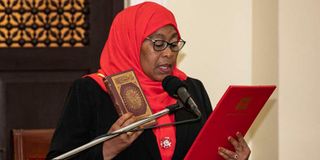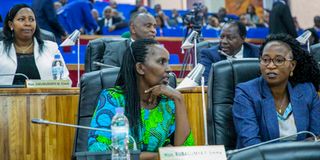Here's the global proportion of women parliamentarians

Tanzanian President Samia Suluhu Hassan during her swearing-in ceremony at State House in Dar es Salaam, as the country's first female President on March 19, 2021.
What you need to know:
- Globally, women hold 25.5 per cent of both Parliament and Senate combined.
- Only Rwanda and Cuba have more women parliamentarians in the lower house than men in the world.
- According to a Cambridge University research, female lawmakers are more likely to advocate for policy that support education and health.
Twenty six years after the Beijing Declaration and Platform for Action, which set the international target for reaching gender balance in political decision-making, women are still underrepresented across all levels of power.
On average, globally, women hold 25.5 per cent of both houses combined (Parliament and Senate). The gap is actually wider in the Pacific region (20.9 per cent), Middle East and North Africa (17.8 per cent) and Asia (20.4 per cent), and narrower in the Americas (32.4 per cent) and Europe (30.4 per cent). In Sub-Saharan Africa the average is nearly equal to the global average (25 per cent).
Only two countries in the world have more women parliamentarians in the lower house than men (Rwanda, Cuba) and one has 50/50 parity in Parliament (UAE), as of January 1st 2021.
The only three countries that have more women than men in the Senate are Australia (51.3 per cent), Antigua and Barbuda (52.9 per cent) and Bolivia (55.6 per cent), followed closely by Mexico (49.2 per cent).

Some of Rwanda's female parliamentarians. In addition to the many women in decision-making organs, Rwandan women in the government do not seem to have been relegated to traditional women’s positions.
Only 22 out of 193 countries have a women as Head of Government (Bangladesh, Barbados, Belgium, Denmark, Estonia, Ethiopia, Tanzania, Finland, Gabon, Georgia, Germany, Iceland, Nepal, New Zealand, Norway, San Marino, Serbia, Singapore, Slovakia, Switzerland, Trinidad and Tobago), ten of which are also Head of State.
There are 119 countries that have never had a woman leader according to the UN, which underlines that at the current rate, gender equality in the highest positions of power will not be attained for another 130 years.
In 2021, only 13 countries have 50 per cent or more women in ministerial positions (Nicaragua, Austria, Belgium, Sweden, Albania, Rwanda, Costa Rica, Canada, Andorra, Finland, France, Guinea-Bissau and Spain). Globally, most women ministers tend to hold portfolios linked to family and children’s affairs, social affairs, environment, employment and gender equality.
In a study conducted by the Inter-parliamentary Union in 39 countries across five regions in 2016, 82 per cent of women parliamentarians who participated reported having experienced some form of psychological violence (remarks, gestures and images of a sexist or humiliating sexual nature made against them or threats and/or mobbing) while serving their terms.
Yet…
According to a Cambridge University research, female lawmakers are more likely to advocate for policy that support education and health — they are also more likely to pass and implement legislation that advances gender equality, including laws on domestic violence, rape, and sexual harassment.
According to the Council on Foreign Relations, when women’s parliamentary representation increases by five per cent, a country is almost five times less likely to respond to an international crisis with violence. Within countries, women’s parliamentary representation is associated with a decreased risk of civil war and lower levels of State-perpetrated human rights abuses, such as disappearances, killings, political imprisonment, and torture.
Towards Equality’s Media Partners’ countries up close:
In Afghanistan (which ranks 71 out of 193 countries analysed by the UN in regards to gender parity in Parliament) women currently hold 27 per cent of the Lower House and 27.9 per cent of the Senate or Upper House in Parliament (see Afghanistan’s piece on Women’s share in Parliament here). Women hold 6.5 per cent of the country’s ministerial positions (two out of 31).
In Argentina (which ranks 18 out of 193 countries analysed by the UN in regards to gender parity in Parliament) women hold 42.4 per cent of the Lower House and 40.3 per cent of the Senate or Upper House in Parliament. A woman is currently speaker of Parliament. Women hold 18.2 per cent of the country’s ministerial positions (four out of 22).
In Brazil (which ranks 142 out of 193 countries analysed by the UN in regards to gender parity in Parliament) women hold 15.2 per cent of the Lower House and 12.4 per cent of the Senate or Upper House in Parliament. Women hold 10.5 per cent of the country’s ministerial positions (two out of 19).
In France (which ranks 27 out of 193 countries analysed by the UN in regards to gender parity in Parliament) women currently hold 34.8 per cent of the Lower House and 12.4 per cent of the Senate or Upper House in Parliament. Women hold 50 per cent of the country’s ministerial positions (nine out of 18).
In Italy (which ranks 35 out of 193 countries analysed by the UN in regards to gender parity in Parliament, tied with Guyana) women currently hold 35.7 per cent of the Lower House and 34.4 per cent of the Senate or Upper House in Parliament. A woman is currently speaker of Parliament. Women hold 36.4 per cent of the country’s ministerial positions (eight out of 22).
In Japan (which ranks 166 out of 193 countries analysed by the UN in regards to gender parity in Parliament) women currently hold 9.9 per cent of the Lower House and 23 per cent of the Senate or Upper House in Parliament. A woman is currently speaker of Parliament. Women hold 10 per cent of the country’s ministerial positions (two out of 20).

Kenyan women march in the streets of Nairobi last year, to demand for the implementation of the two-thirds gender rule as provided in the Constitution which states that not more than two-thirds of members of all elective and appointive positions are of the same gender.
In Kenya (which ranks 105 out of 193 countries analysed by the UN in regards to gender parity in Parliament, tied with Fiji and Cambodia) women currently hold 21.6 per cent of the Lower House and 12.4 per cent of the Senate or Upper House in Parliament. Women hold 31.8 per cent of the country’s ministerial positions (seven out of 23).
In Lebanon (which ranks 183 out of 193 countries analysed by the UN in regards to gender parity in Parliament) women currently hold 4.7 per cent of the Parliament (MPs chamber). The country doesn’t have a Senate. Women hold 31.6 per cent of the country’s ministerial positions (six out of 19).
In Morocco (which ranks 114 out of 193 countries analysed by the UN in regards to gender parity in Parliament) women currently hold 20.5 per cent of the Lower House and 11.7 per cent of the Senate or Upper House in Parliament. Women hold 15.8 per cent of the country’s ministerial positions (three out of 19).
In South Africa (which ranks 12 out of 193 countries analysed by the UN in regards to gender parity in Parliament) women currently hold 45.8 per cent of the Lower House and 41.5 per cent of the Senate or Upper House in Parliament. A woman is currently speaker of Parliament. Women hold 48.3 per cent of the country’s ministerial positions (14 out of 29).
In Spain (which ranks 16 out of 193 countries analysed by the UN in regards to gender parity in Parliament) women currently hold 44 per cent of the Lower House and 40.8 per cent of the Senate or Upper House in Parliament. A woman is currently speaker of Parliament. Women hold 50 per cent of the country’s ministerial positions (11 out of 22).
In Switzerland (which ranks 20 out of 193 countries analysed by the UN in regards to gender parity in Parliament) women currently hold 42 per cent of the Lower House and 26.1 per cent of the Senate or Upper House in Parliament. Women hold 42.9 per cent of the country’s ministerial positions (three out of seven).
In the United Kingdom (which ranks 39 out of 193 countries analysed by the UN in regards to gender parity in Parliament, tied with Cameroon) women currently hold 33.9 per cent of the Lower House and 27.9 per cent of the Senate or Upper House in Parliament. Women hold 23.8 per cent of the country’s ministerial positions (five out of 21).
This article is published within the framework of "Towards Equality", a collaborative journalism operation gathering 15 news media from all over the world highlighting the challenges and solutions to achieve gender equality.





